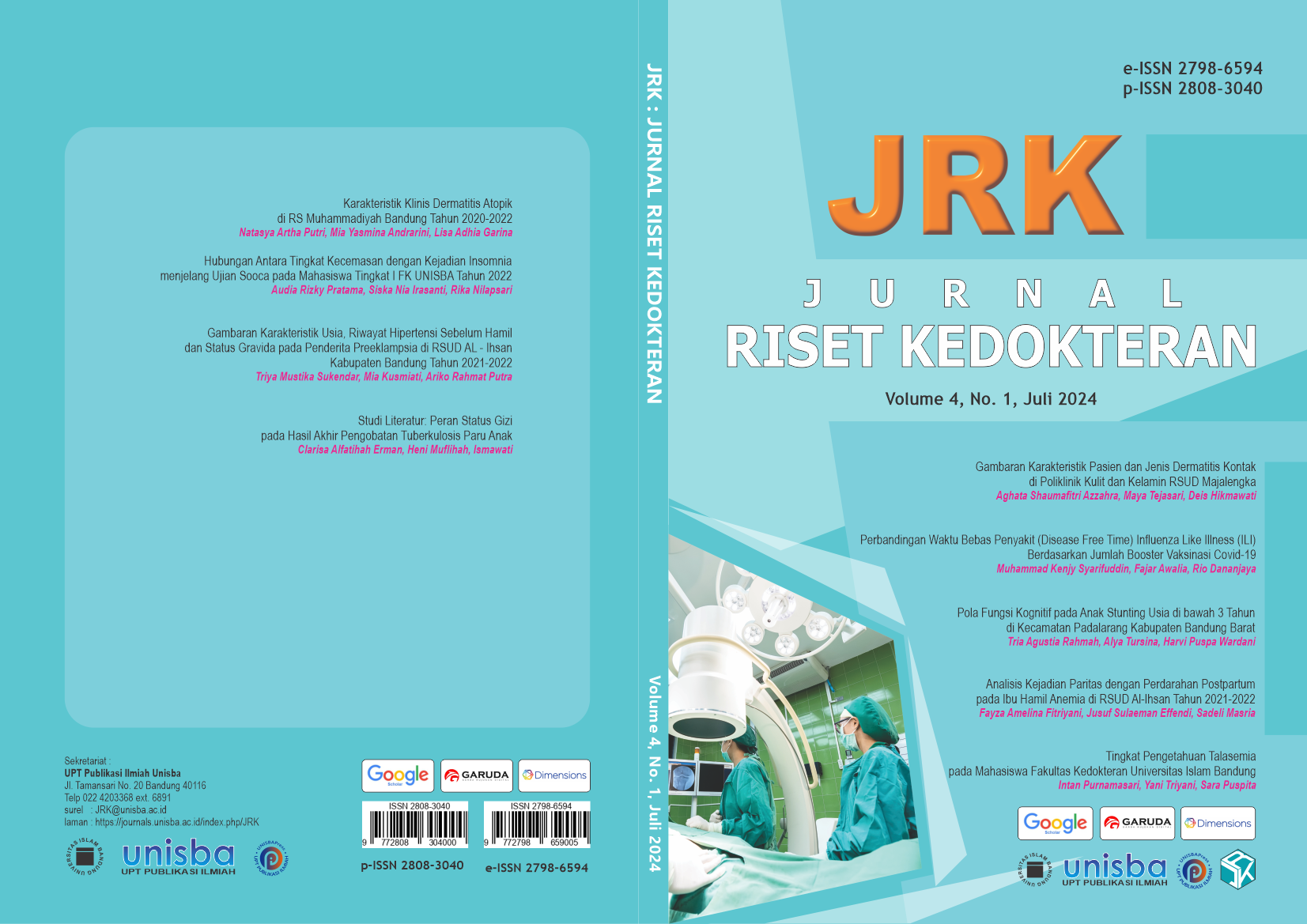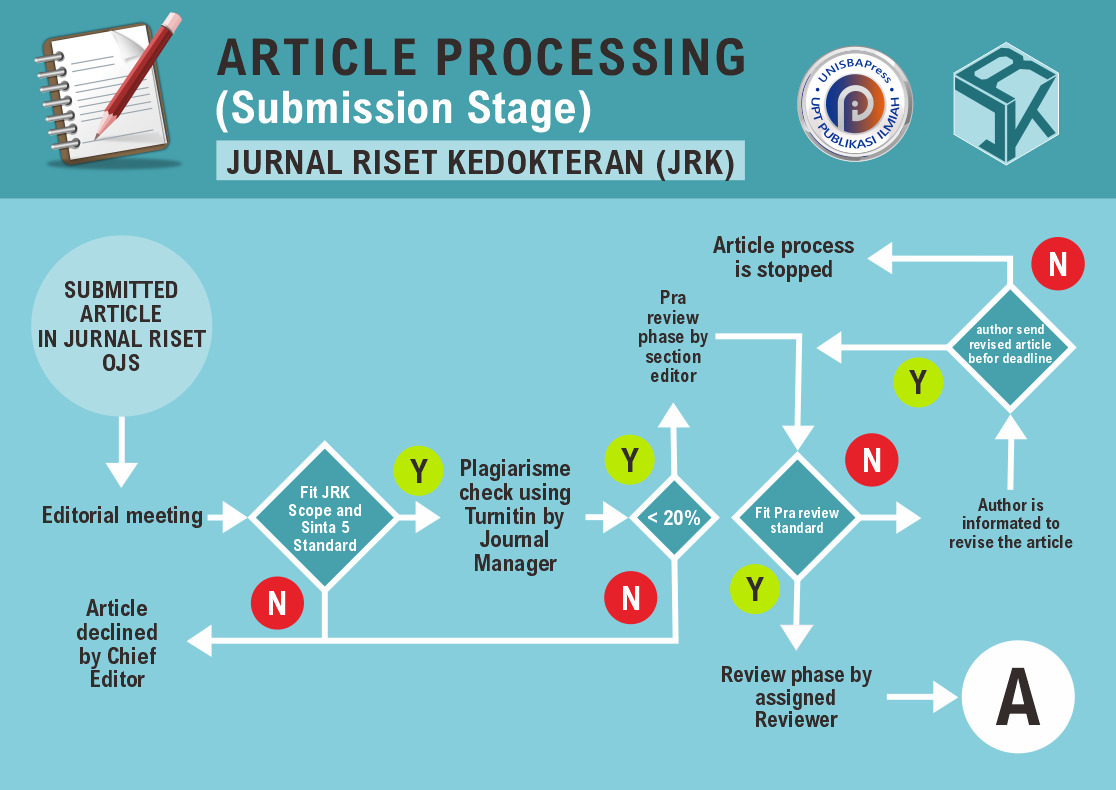Pola Fungsi Kognitif pada Anak Stunting Usia di bawah 3 Tahun di Kecamatan Padalarang Kabupaten Bandung Barat
DOI:
https://doi.org/10.29313/jrk.v4i1.3709Keywords:
Capute Scales, Fungsi Kognitif, StuntingAbstract
Abstract. The purpose of this study was to determine the correlation between the degree of stunting and the cognitive function of children under 3 years old. This research is an observational analytic study with a cross sectional approach. Sample selection was done through total sampling with 75 stunting children under 3 years old. Data collection used the Capute Scales questionare. The data were analyzed using the chi-square test and the result of the analysis of the correlation between the degree of stunting and cognitive function in children under 3 years old showed a p value=0.00002 and a strong correlation level (R 0.626). There is a significant correlation between the degree of stunting and cognitive function. The impact of stunting can lead to suboptimal child development, resulting in decreased cognitive performance and educational achievement compared to well-nourished children, potentially causing permanent physical and cognitive damage.
Abstrak. Tujuan penelitian ini adalah untuk mengetahui hubungan antara derajat stunting dengan fungsi kognitif anak usia di bawah 3 tahun. Jenis penelitian ini adalah analitik observasional dengan pendekatan cross sectional. Pemilihan sampel secara total sampling dengan jumlah subjek 75 anak stunting usia di bawah 3 tahun. Pengambilan data menggunakan kuesioner Capute Scales. Data dianalisis menggunakan uji chi-square, hasil analisis hubungan antara derajat stunting dengan fungsi kognitif pada anak usia dibawah 3 tahun menunjukan p value=0,00002 dan tingkat hubungan yang kuat (R 0,626). Terdapat hubungan yang bermakna antara derajat stunting dengan fungsi kognitif. Pengaruh stunting dapat menyebabkan tumbuh kembang pada anak menjadi tidak optimal, sehingga kinerja kognitif dan prestasi pendidikan menjadi menurun dibandingkan dengan anak-anak yang bergizi baik dan dapat berpotensi menyebabkan kerusakan pada fisik dan kognitif secara permanen.
References
. Vaivada T, Akseer N, Akseer S, Somaskandan A, Stefopulos M, Bhutta Z A. Stunting in childhood: an overview of global burden, trends, determinants, and drivers of decline. Am J Clin Nutr. 2020;112(2):777S-791S.
. BPPN. Pedoman Pelaksanaan Intervensi Penurunan Stunting Terintegrasi Di Kabupaten/ Kota. 2018.
. Kemenkes. Buku saku Hasil Studi Status Gizi Indonesia (SSGI) Tingkat Nasional, Provinsi, dan Kabupaten/Kota Tahun 2021. Jakarta; 2021.
. Yunitasari E, Lee B O, Krisnana I, Lugina R, Solikhah F K, Aditya R S. Determining the Factors That Influence Stunting during Pandemic in Rural Indonesia: A Mixed Method. Child (Basel). 2022;9(8):1189.
. UNICEF. Malnutrition prevalence remains alarming: stunting is declining too slowly while wasting still impacts the lives of far too many young children [Internet]. UNICEF. 2020.
. VanPutte et al. Seeley’s anatomy & physiology. New York: McGraw-Hill; 2014.
. Prendergast AJ HJ. The stunting syndrome in developing countries. Paediatr Int Child Heal. 2018;34(4):250-65.
. Vonaesch P, Randremanana R, Gody J C, Collard J M, Vernick T G, Doria M et al. AFRIBIOTA Investigators. Identifying the etiology and pathophysiology underlying stunting and environmental enteropathy: study protocol of the AFRIBIOTA project. BMC Pediatr. 2018;18(1):236.
Rahayu PP, Casnuri. Perbedaan Risiko Stunting Berdasarkan Jenis Kelamin. Semin Nas UNRIYO. 2020;135–9.
Hatijar H. The Incidence of Stunting in Infants and Toddlers. J Ilm Kesehat Sandi Husada. 2023;12(1):224–9.
Sigar RJ D. Gambaran fungsi kognisi pada pasien epilepsi di poliklinik saraf RSUP Prof. Dr. R.D. Kandou Manado. J e-Clinic. 2018;5(2):338–48.
Aurora WID, Sitorus RJ, Flora R. Perbandingan Skor IQ (Intellectual Question) Pada Anak Stunting dan Normal. JAMBI Med J “Jurnal Kedokt dan Kesehatan.” 2020;8(1):19–25.
Woldehanna T, Behrman JR, Araya MW. The effect of early childhood stunting on children’s cognitive achievements: Evidence from young lives Ethiopia. Ethiop J Heal Dev. 2018;31(2):75–84.
Handryastuti S, Pusponegoro H D, Nurdadi S, Chandra A, Pramita F A, Soebadi A et al. Comparison of Cognitive Function in Children with Stunting and Children with Undernutrition with Normal Stature. J Nutr Metab. 2022;
Yadika ADN, Berawi KN, Nasution SH. Pengaruh stunting terhadap perkembangan kognitif dan prestasi belajar. J Major. 2019;8(2):273–82.
Daracantika A, Ainin, Besral. Systematic Literature Review : The Negative Effect of Stunting on Children ’ s Cognitive Development Berdasarkan data Riset Kesehatan Dasar tidak optimalnya kemam. J BIKFOKES. 2020;1(2):124–36.
Ekholuenetale M, Barrow A, Ekholuenetale CE, Tudeme G. Impact of stunting on early childhood cognitive development in Benin: evidence from Demographic and Health Survey. Egypt Pediatr Assoc Gaz. 2020;68(1):1–11













